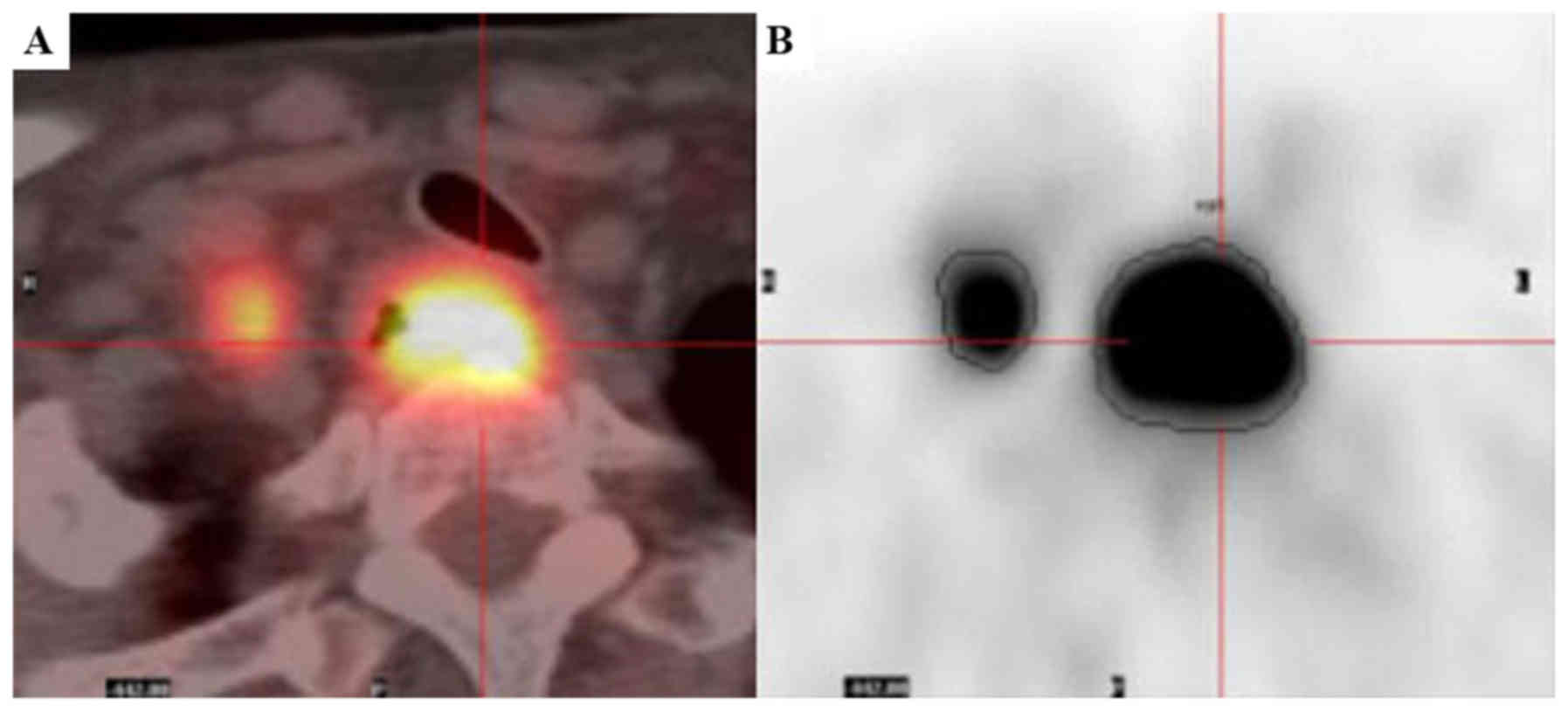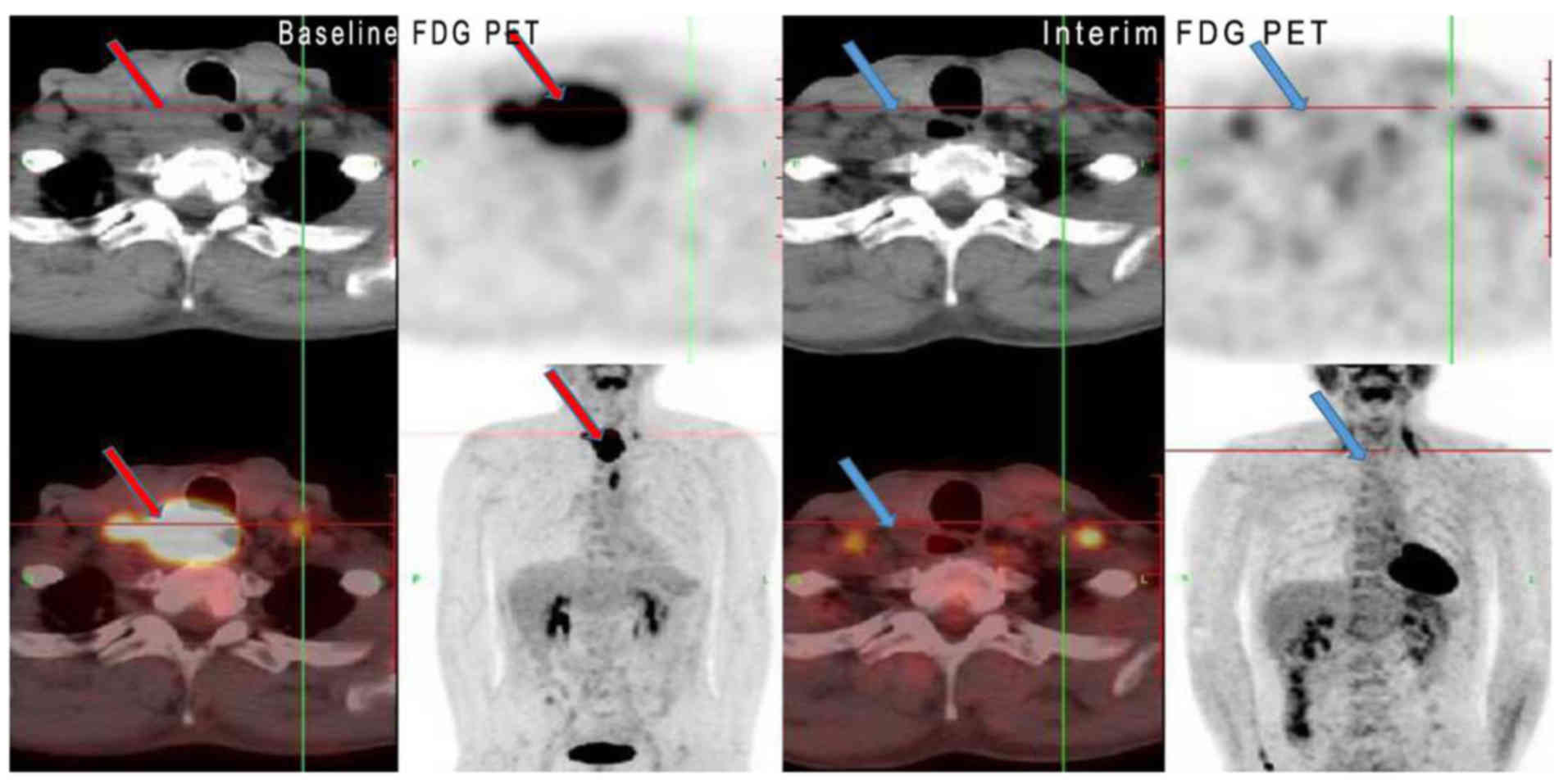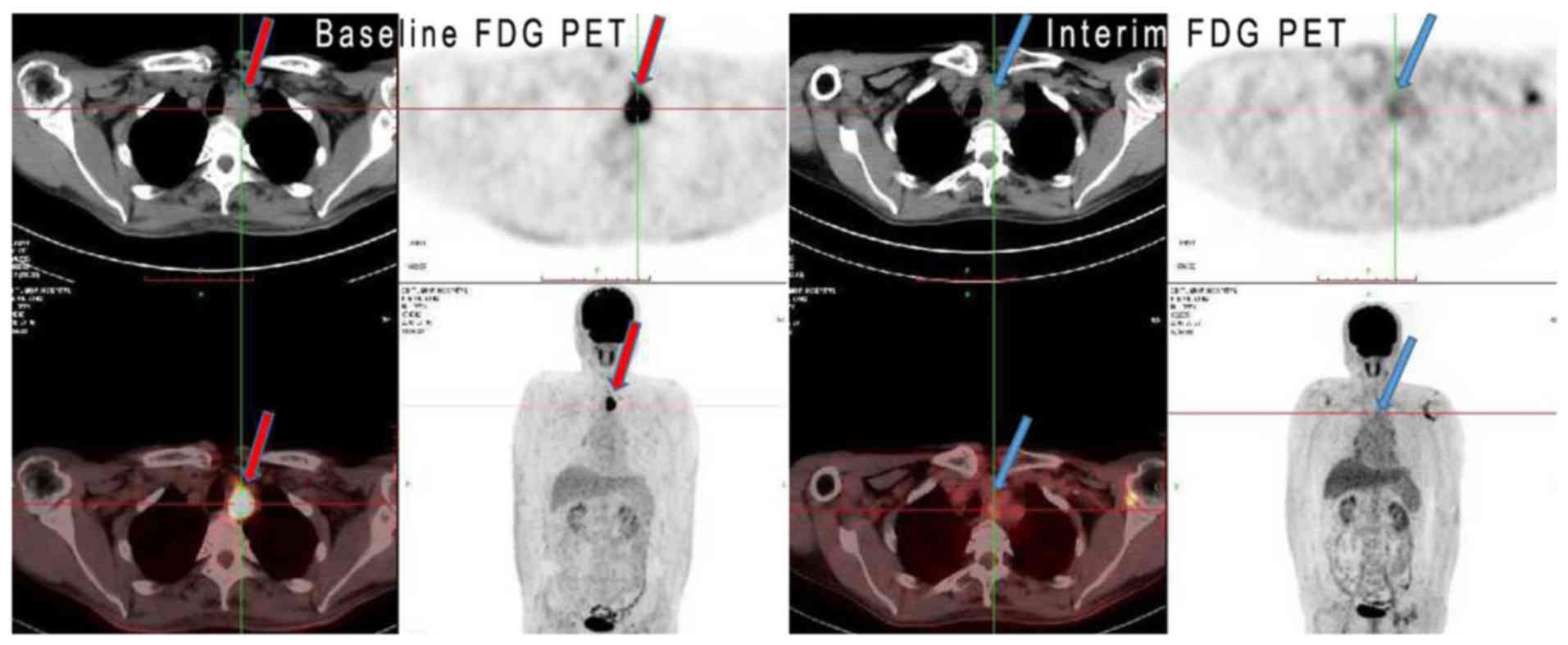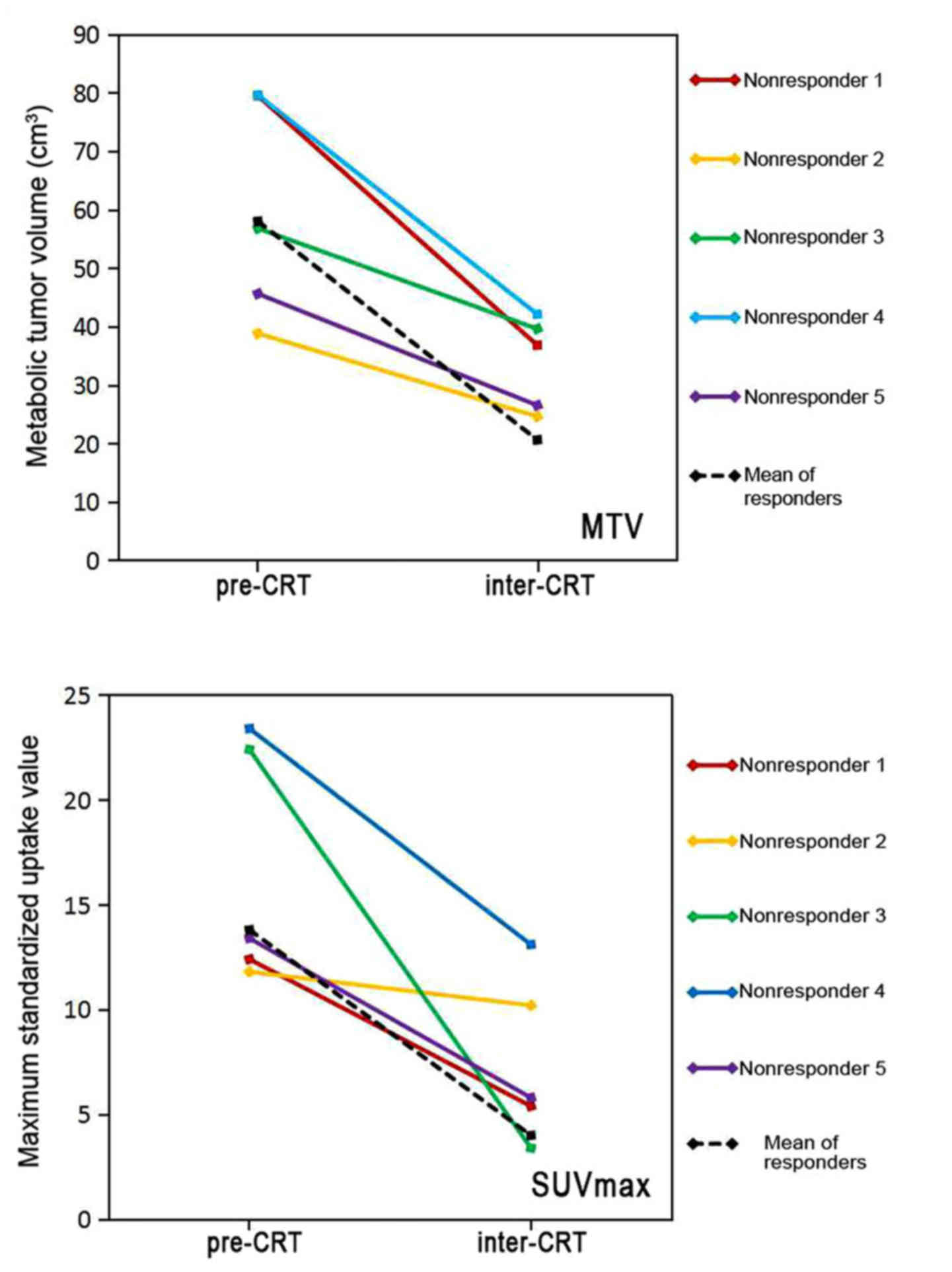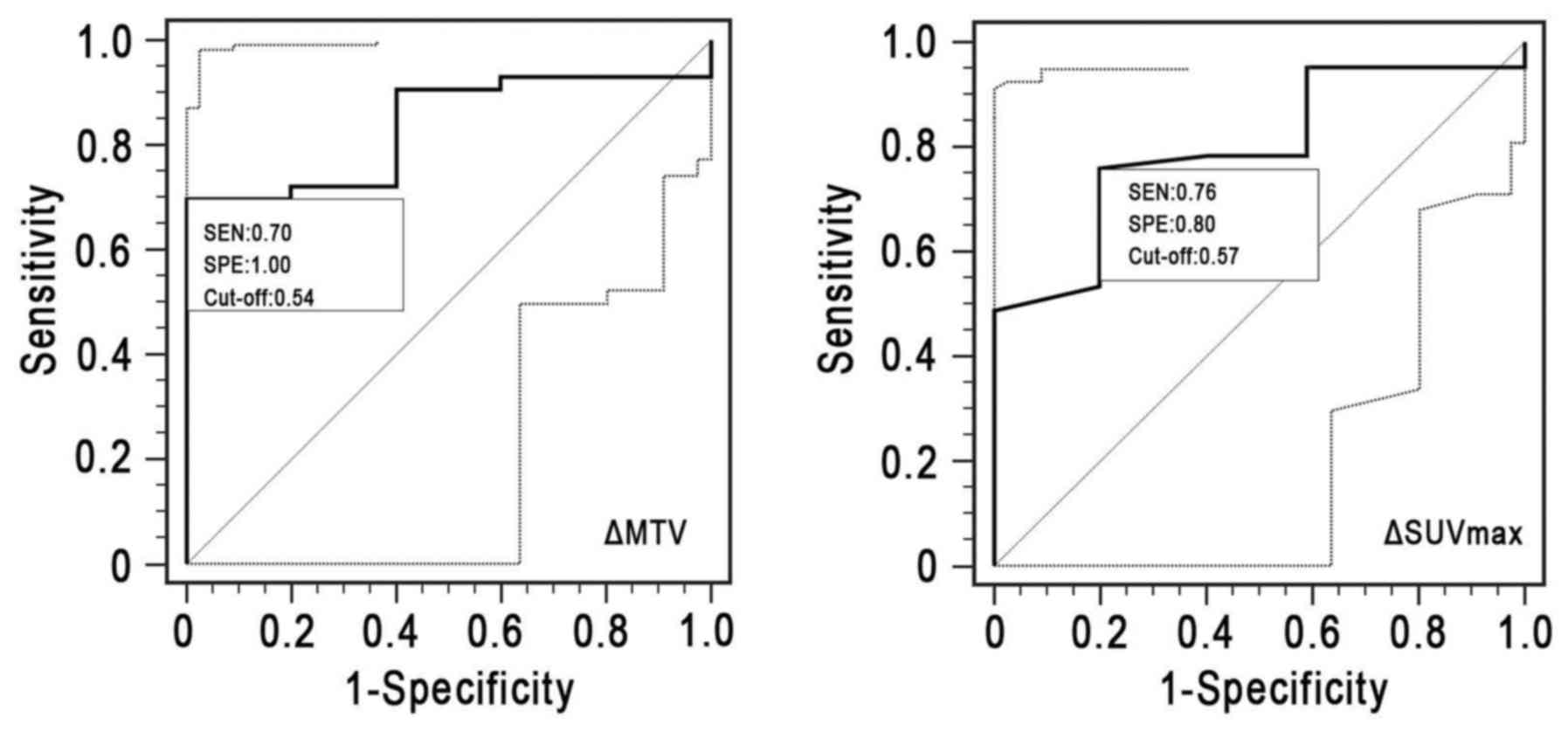|
1
|
Chen W, He Y, Zheng R, Zhang S, Zeng H,
Zou X and He J: Esophageal cancer incidence and mortality in China,
2009. J Thorac Dis. 5:19–26. 2013.PubMed/NCBI
|
|
2
|
Cooper JS, Guo MD, Herskovic A, Macdonald
JS, Martenson JA Jr, Al-Sarraf M, Byhardt R, Russell AH, Beitler
JJ, Spencer S, et al: Chemoradiotherapy of locally advanced
esophageal cancer: Long-term follow-up of a prospective randomized
trial (RTOG 85-01). Radiation therapy oncology group. JAMA.
281:1623–1627. 1999. View Article : Google Scholar : PubMed/NCBI
|
|
3
|
Ajani J, Bekaii-Saab T, D'Amico TA, Fuchs
C, Gibson MK, Goldberg M, Hayman JA, Ilson DH, Javle M, Kelley S,
et al: Esophageal cancer clinical practice guidelines. J Natl Compr
Canc Netw. 4:328–347. 2006. View Article : Google Scholar : PubMed/NCBI
|
|
4
|
Wieder HA, Ott K, Lordick F, Becker K,
Stahl A, Herrmann K, Fink U, Siewert JR, Schwaiger M and Weber WA:
Prediction of tumor response by FDG-PET: Comparison of the accuracy
of single and sequential studies in patients with adenocarcinomas
of the esophagogastric junction. Eur J Nucl Med Mol Imaging.
34:1925–1932. 2007. View Article : Google Scholar : PubMed/NCBI
|
|
5
|
Lordick F, Ott K, Krause BJ, Weber WA,
Becker K, Stein HJ, Lorenzen S, Schuster T, Wieder H, Herrmann K,
et al: PET to assess early metabolic response and to guide
treatment of adenocarcinoma of the oesophagogastric junction: The
MUNICON phase II trial. Lancet Oncol. 8:797–705. 2007. View Article : Google Scholar : PubMed/NCBI
|
|
6
|
Kim SJ, Koo PJ and Chang S: Predictive
value of repeated F-18 FDG PET/CT parameters changes during
preoperative chemoradiotherapy to predict pathologic response and
overall survival in locally advanced esophageal adenocarcinoma
patients. Cancer Chemother Pharmacol. 77:723–731. 2016. View Article : Google Scholar : PubMed/NCBI
|
|
7
|
Wieder HA, Brücher BL, Zimmermann F,
Becker K, Lordick F, Beer A, Schwaiger M, Fink U, Siewert JR, Stein
HJ and Weber WA: Time course of tumor metabolic activity during
chemoradiotherapy of esophageal squamous cell carcinoma and
response to treatment. J Clin Oncol. 22:900–908. 2004. View Article : Google Scholar : PubMed/NCBI
|
|
8
|
Swisher SG, Erasmus J, Maish M, Correa AM,
Macapinlac H, Ajani JA, Cox JD, Komaki RR, Hong D, Lee HK, et al:
2-Fluoro-2-deoxy-D-glucose positron emission tomography imaging is
predictive of pathologic response and survival after preoperative
chemoradiation in patients with esophageal carcinoma. Cancer.
101:1776–1785. 2004. View Article : Google Scholar : PubMed/NCBI
|
|
9
|
Vali FS, Nagda S, Hall W, Sinacore J, Gao
M, Lee SH, Hong R, Shoup M and Emami B: Comparison of standardized
uptake value-based positron emission tomography and computed
tomography target volumes in esophageal cancer patients undergoing
radiotherapy. Int J Radiat Oncol Biol Phys. 78:1057–1063. 2010.
View Article : Google Scholar : PubMed/NCBI
|
|
10
|
Jeganathan R, McGuigan J, Campbell F and
Lynch T: Does pre-operative estimation of oesophageal tumour
metabolic length using 18F-fluorodeoxyglucose PET/CT images compare
with surgical pathology length? Eur J Nucl Med Mol Imaging.
38:656–662. 2011. View Article : Google Scholar : PubMed/NCBI
|
|
11
|
Wahl RL, Jacene H, Kasamon Y and Lodge MA:
From RECIST to PERCIST: Evolving considerations for PET response
criteria in solid tumors. J Nucl Med. 50 Suppl 1:122S–150S. 2009.
View Article : Google Scholar : PubMed/NCBI
|
|
12
|
Edge SB, Byrd DR, Compton CC, Fritz AG,
Greene FL and Trotti A: From the AJCC cancer staging manualAJCC
Cancer Staging Handbook. 7th. Springer; New York, NY: 2010
|
|
13
|
Elimova E, Wang X, Etchebehere E, Shiozaki
H, Shimodaira Y, Wadhwa R, Planjery V, Charalampakis N, Blum MA,
Hofstetter W, et al: 18F-FDG PET/CT as predictive of response after
chemoradiation in esophageal cancer patients. Eur J Cancer.
51:2545–2552. 2015. View Article : Google Scholar : PubMed/NCBI
|
|
14
|
Findlay JM, Middleton MR and Tomlinson I:
A systematic review and meta-analysis of somatic and germline DNA
sequence biomarkers of esophageal cancer survival, therapy response
and stage. Ann Oncol. 26:624–644. 2015. View Article : Google Scholar : PubMed/NCBI
|
|
15
|
Sato Y, Motoyama S, Saito H and Minamiya
Y: Novel candidate biomarkers of chemoradiosensitivity in
esophageal squamous cell carcinoma: A systematic review. Eur Surg
Res. 56:141–153. 2016. View Article : Google Scholar : PubMed/NCBI
|
|
16
|
Monjazeb AM, Riedlinger G, Aklilu M,
Geisinger KR, Mishra G, Isom S, Clark P, Levine EA and Blackstock
AW: Outcomes of patients with esophageal cancer staged with
[18F]fluorodeoxyglucose positron emission tomography (FDG-PET): Can
postchemoradiotherapy FDG-PET predict the utility of resection? J
Clin Oncol. 28:4714–4721. 2010. View Article : Google Scholar : PubMed/NCBI
|
|
17
|
Yuan H, Tong DK, Vardhanabhuti V, Law SY,
Chiu KW and Khong PL: PET/CT in the evaluation of treatment
response to neoadjuvant chemoradiotherapy and prognostication in
patients with locally advanced esophageal squamous cell carcinoma.
Nucl Med Commun. 37:947–955. 2016. View Article : Google Scholar : PubMed/NCBI
|
|
18
|
Chhabra A, Ong LT, Kuk D, Ku G, Ilson D,
Janjigian YY, Wu A, Schöder H and Goodman KA: Prognostic
significance of PET assessment of metabolic response to therapy in
oesophageal squamous cell carcinoma. Br J Cancer. 113:1658–1665.
2015. View Article : Google Scholar : PubMed/NCBI
|
|
19
|
Huang JW, Yeh HL, Hsu CP, Lu YY, Chuang
CY, Lin JC, Lin JF and Chang CF: To evaluate the treatment response
of locally advanced esophageal cancer after preoperative
chemoradiotherapy by FDG-PET/CT scan. J Chin Med Assoc. 78:229–234.
2015. View Article : Google Scholar : PubMed/NCBI
|
|
20
|
Myslivecek M, Neoral C, Vrba R, Vomackova
K, Cincibuch J, Formanek R, Koranda P and Zapletalova J: The value
of 18F-FDG PET/CT in assessment of metabolic response in esophageal
cancer for prediction of histopathological response and survival
after preoperative chemoradiotherapy. Biomed Pap Med Fac Univ
Palacky Olomouc Czech Repub. 156:171–179. 2012. View Article : Google Scholar : PubMed/NCBI
|
|
21
|
Adams MC, Turkington TG, Wilson JM and
Wong TZ: A systematic review of the factors affecting accuracy of
SUV measurements. AJR Am J Roentgenol. 195:310–320. 2010.
View Article : Google Scholar : PubMed/NCBI
|
|
22
|
Lemarignier C, Di Fiore F, Marre C, Hapdey
S, Modzelewski R, Gouel P, Michel P, Dubray B and Vera P:
Pretreatment metabolic tumour volume is predictive of disease-free
survival and overall survival in patients with oesophageal squamous
cell carcinoma. Eur J Nucl Med Mol Imaging. 41:2008–2016. 2014.
View Article : Google Scholar : PubMed/NCBI
|
|
23
|
Chang S, Koo PJ, Kwak JJ and Kim SJ:
Changes in total lesion glycolysis evaluated by repeated F-18 FDG
PET/CT as prognostic factor in locally advanced esophageal cancer
patients treated with preoperative chemoradiotherapy. Oncology.
90:97–102. 2016. View Article : Google Scholar : PubMed/NCBI
|
|
24
|
Roedl JB, Colen RR, Holalkere NS, Fischman
AJ, Choi NC and Blake MA: Adenocarcinomas of the esophagus:
Response to chemoradiotherapy is associated with decrease of
metabolic tumor volume as measured on PET-CT. Comparison to
histopathologic and clinical response evaluation. Radiother Oncol.
89:278–286. 2008. View Article : Google Scholar : PubMed/NCBI
|
|
25
|
Palie O, Michel P, Ménard JF, Rousseau C,
Rio E, Bridji B, Benyoucef A, Meyer ME, Jalali K, Bardet S, et al:
The predictive value of treatment response using FDG PET performed
on day 21 of chemoradiotherapy in patients with oesophageal
squamous cell carcinoma. A prospective, multicentre study (RTEP3).
Eur J Nucl Med Mol Imaging. 40:1345–1355. 2013. View Article : Google Scholar : PubMed/NCBI
|
|
26
|
Shi XH: Advances on esophageal carcinoma
radiotherapy in China. China Oncol. 2001.
|
|
27
|
Lloyd S and Chang BW: Current strategies
in chemoradiation for esophageal cancer. J Gastrointest Oncol.
5:156–165. 2014.PubMed/NCBI
|
|
28
|
Arslan N, Miller TR, Dehdashti F,
Battafarano RJ and Siegel BA: Evaluation of response to neoadjuvant
therapy by quantitative 2-deoxy-2-[18F]fluoro-D-glucose with
positron emission tomography in patients with esophageal cancer.
Mol Imaging Biol. 4:301–310. 2002. View Article : Google Scholar : PubMed/NCBI
|
|
29
|
Yue J, Chen L, Cabrera AR, Sun X, Zhao S,
Zheng F, Han A, Zheng J, Teng X, Ma L, et al: Measuring tumor cell
proliferation with 18F-FLT PET during radiotherapy of esophageal
squamous cell carcinoma: A pilot clinical study. J Nucl Med.
51:528–534. 2010. View Article : Google Scholar : PubMed/NCBI
|



